Many people (including us at first) think that Lapland doesn’t have good food to offer. However, we were blown away by the Lappish cuisine, that is quite diverse, with extraordinary ingredients and a wide range of foods, including vegetables, fruits and mushrooms. In this post, we’ll share some of the dishes we tried in Finland and recommendations of places where you can try them, too!
What You'll Find In This Post:
Berries
Lapland has an abundance of them – strawberries, blueberries, lingonberries, you name it – they have it. They also have a very special berry that is native to the Arctic region – namely the arctic cloudberry (Rubus chamaemorus). It is orange and sweet, it’s kind of delicacy. It is widely used in different dishes, like for example in a typical Finnish coffee with squeaky cheese. What you do is you put pieces of squeaky cheese and cloudberry jam in your cup of Finnish coffee (kahvi), then you drink your coffee. When you get to the end you get to eat the warm and soft squeaky cheese and the cloudberry jam balances the palate. It sounds awful, I know, but actually it’s quite nice, so you should try if you get the chance.
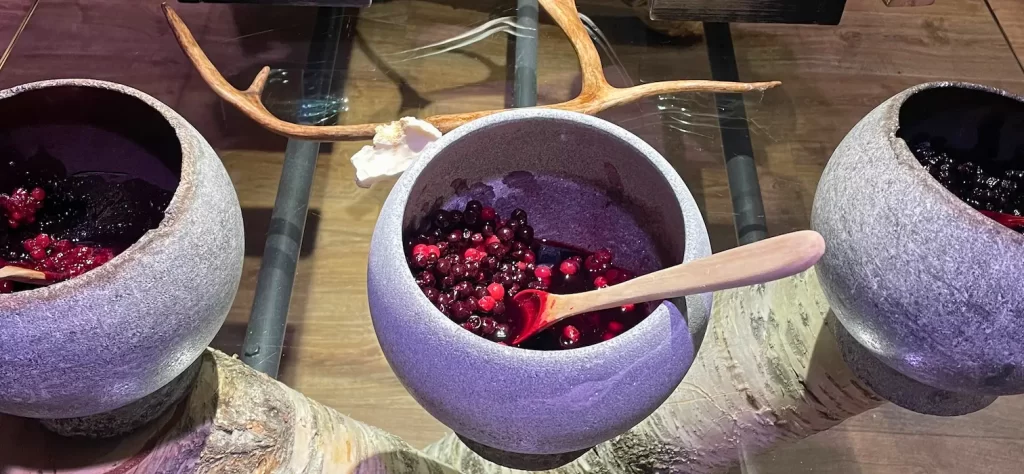
Berries play a big role in Lappish cuisine and culture. The Lappish people have a deep connection to the forest and everything it has to offer. Another main principle is that the forest is for everyone – that means everyone has the right to walk in the forest and gather berries and mushrooms. And that’s exactly what a lot of people do during the harvest season, they collect berries and then freeze them or make them into jam to use throughout the year. The Lappish berries are also quite special because of the unique conditions in which they grow. For about a month or so, the sun doesn’t set in Lapland – it’s just moving up and down on the horizon, so that leads to a very rapid maturing and developing of the sugars in the berries. This in turn gives them a unique sweetness. If you’re visiting in late summer, it might be a nice experience to walk around the forest and forage for berries, even if it’s just to eat them straight away. If you’re visiting at any other time of the year, you can taste the Lappish berries in different forms, most commonly as a jam or (hot) berry juice. The hot berry juice is the signature drink in Lapland in the winter, it’s everywhere, and I mean everywhere. It also tastes amazing and warms your soul on a bitter-cold January day. It is a definite recommendation to try.
Salmon
Salmon is a staple in the North, and the Arctic salmon is undoubtedly one of the better ones you can get. The Finns have different dishes with salmon, but most commonly you’ll get it as a soup or grilled.
Creamy salmon soup
This is a soup that you can find in any traditional restaurant in Finland. They will all have a slightly differing recipe, but overall, it is a very simple dish – salmon, potatoes, dill and cream. The salmon and potatoes are chopped and you get big chunks of meat in your soup that really melts in your mouth. We tried it in two different places and both times it was absolutely delicious and I don’t normally like soup. It reminds me a bit of chicken soup, only it tastes much better. Furthermore, it is served with Finnish rye bread on the side, and we find it to be the ultimate warming dish on a cold Lappish winter day.

Grilled salmon
Another traditional way to prepare salmon is to grill it and serve it together with root vegetables and Finnish potato salad. It is mouth-watering, the smell of a freshly grilled fresh salmon..mmm. Again, you can find this dish in any traditional restaurant around Lapland. Keep reading on for our recommendations at the end of the article.
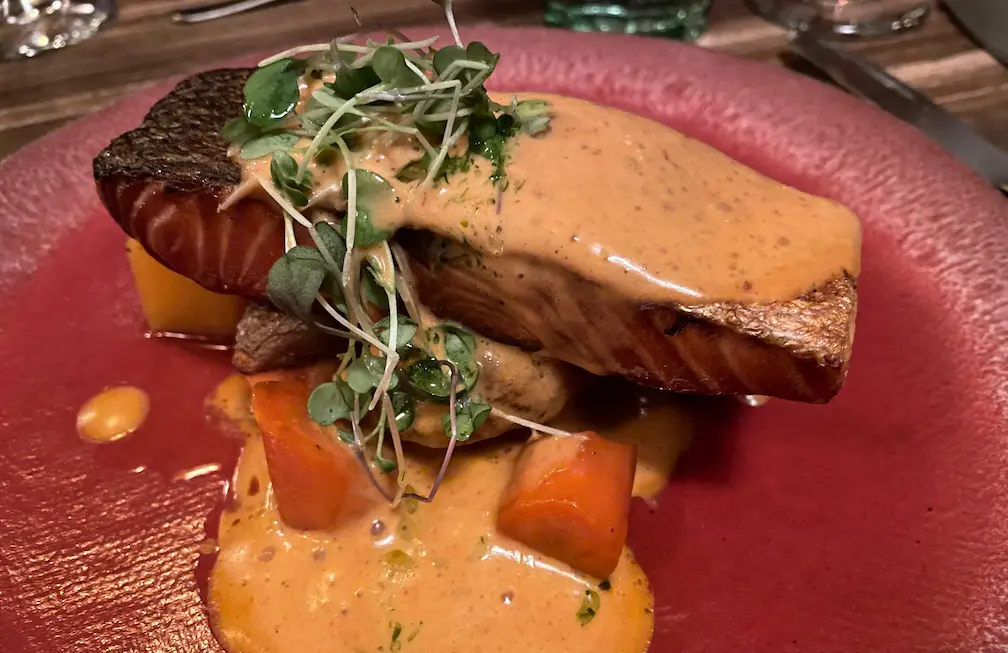
Smoked salmon spread
A bit more unconventional way to prepare salmon is to make a spread out of the smoked fish. They offered us this as complement from the kitchen in restaurant Nili in Rovaniemi (more about it at the end of the article). You can also buy the spread from the supermarket, but it goes without saying that even the more expensive stuff can’t compare with freshly prepared spread in a decent restaurant. You will typically eat this with Finnish rye bread.

Mushrooms
Mushrooms are another gift of the forest and Finns collect a ton of them – they even export porcini (cep) to Italy. As with the berries, you can walk freely and try to forage them, although you shouldn’t really do this unless you’re familiar with the different types, so you can ensure that you only pick the edible ones. You’ll find mushrooms on the menu in practically any restaurant that you visit and a lot of them will offer something like forest mushroom soup. Below are two suggestions of how to try mushrooms in Lapland.
Creamy porcini (cep) mushroom soup
A very good dish to try if you like mushrooms is the creamy porcini (English also cep) soup. It’s porcini mushrooms braised in sour cream and in most places served in the traditional Sami cup – Kuksa, which is an experience on its own. The cup is handmade out of birchwood and every piece is unique.
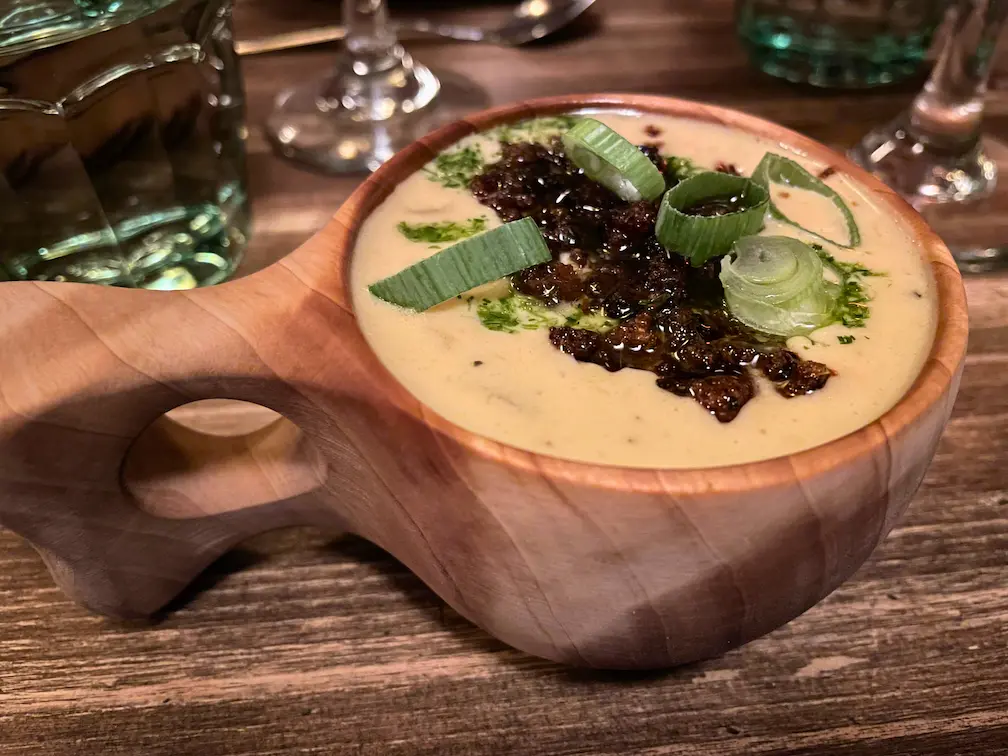
Chaga mushroom
Another staple of the North is the chaga mushroom. It’s a rock-like mushroom that typically grows on the bark of birch trees in cold climates. It’s been used by the Sami people for hundreds, if not thousands of years and many swear by its health benefits. It boosts your immune system and antioxidant activity, has antimicrobial properties, and may even help prevent cancer.
The Finns normally have it as a tea and nowadays, there are some modern fancy drinks like chaga chai lattes or coffee beverages with chaga chai syrup.
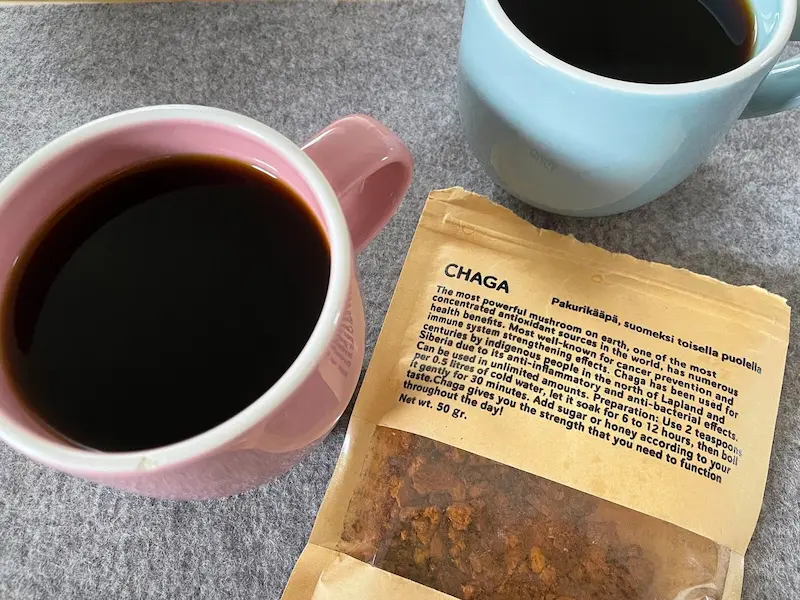
Reindeer
Throughout history, hunting and preparing meat was essential for the Finns. Nowadays, hunting might not be a thing any more, but meat still remains their main source of protein, and reindeer meat is their staple. It is rich in vitamins and packed with protein, but it’s also very lean meat – meaning you get all of the protein and not a lot of fat. It’s a tender and succulent meat, and the Finns prepare it in various different forms. It is also their centrepiece at the Christmas dinner table. Today, you can find it even as the meat in a number of international and foreign dishes such as curries, burger, pizza or kebab. Following are just a few options of how to try the reindeer meat, that we’ve eaten ourselves.
Sautéed reindeer
A very traditional dish is the sautéed reindeer. Its origins lie in Finland, but today it is enjoyed across Scandinavia. It’s served over mashed potatoes with pickled cucumbers and lingonberry jam on the side. The meat is tender, but crisp.
Roasted reindeer
Preparing a roasted reindeer is a lengthy process that includes braising the meat overnight to make it extra tender. Every restaurant will have their own recipe and their own take on this dish, some serving in Port wine sauce, others will use a more traditional sauce, like thyme, and serve it over potato terrine. You can pick what sound better to you, but the reindeer meat will be fantastic whichever you decide to go with.
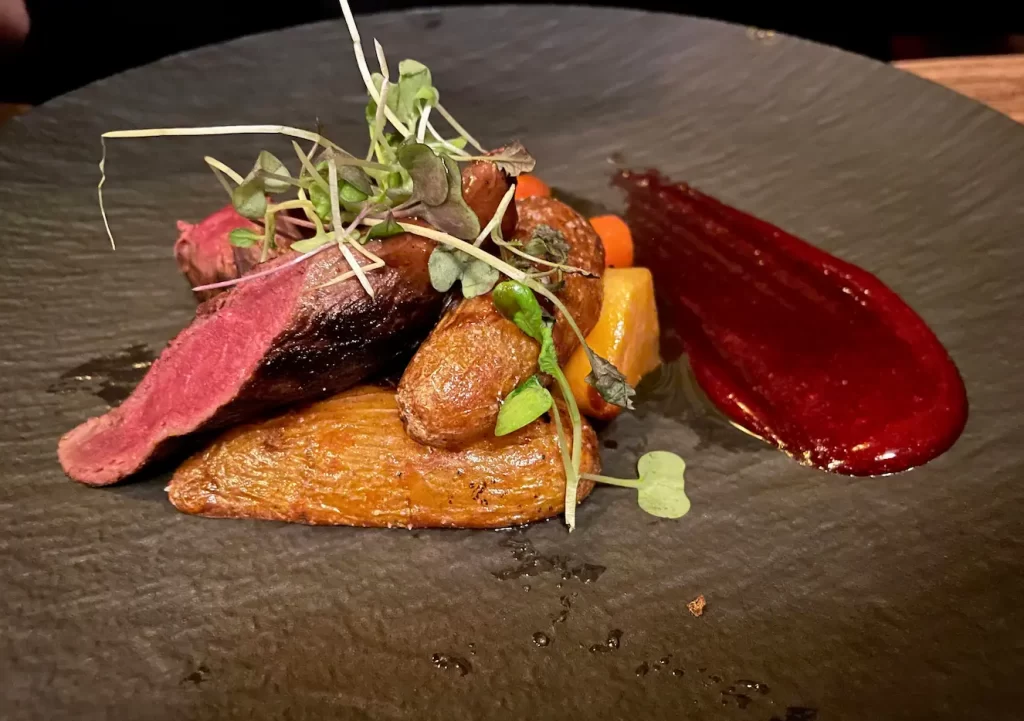
Reindeer burger
Now, this is not really a traditional Finnish dish, but I wanted to include it because I found it to be absolutely magnificent. Also, it’s an option for those who are not very big on fancy meals to try the meat. You can find a reindeer burger in some more modern bistros and restaurants and again each will have their different take on it (I’ve tried one with lingonberry mayonnaise for instance). Check our restaurant recommendations below for some good places to try this.
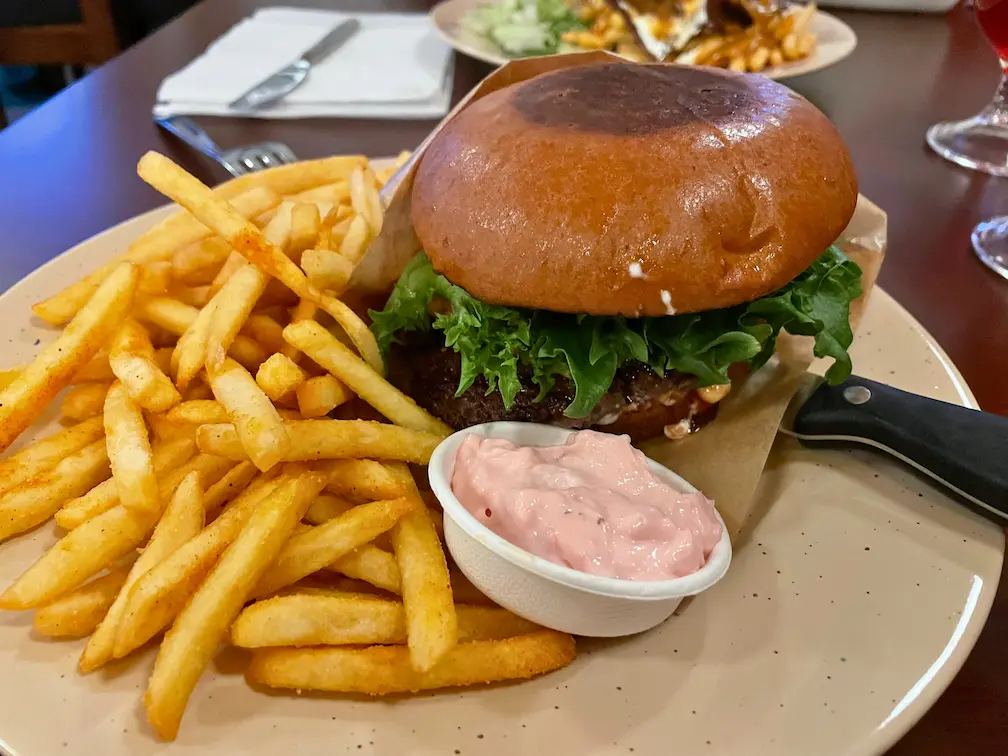
Dairy
One study has found that the Finns consume about 130 litres of milk per capita, which means they’re one of the highest consumers of milk in the world. There is an overwhelming number of dairy products in their supermarkets. Nowadays, you mostly get what you can get in any normal European supermarket – yogurts, cream cheeses, semi-soft and hard cheeses etc. However, I wanted to mention one type of cheese specifically:
Bread cheese (Finnish squeaky cheese)
This special cheese originates in Northern Finland and is typically prepared from either cow’s or reindeer’s milk (most of the conventional brands you’ll find in a supermarket are from cow’s milk). It is a fresh, semi-soft cheese, that has a relatively neutral flavour. It is served in slices as a side with coffee or you can also put pieces of it in your coffee, so it soaks up the flavour. You can eat the bread cheese either cold or warm, for example as a dessert, fried until soft and then served with a jam, normally cloudberry. I find that it is one of those strange things that are at the core of exploring a new and different culture, so it’s a definite recommendation from us.
Our restaurant recommendations in Lapland, Finland
The restaurant scene in Rovaniemi and Lapland is on the up, but could be a bit pricy, too. You are looking at about 80-100 EUR for a 3-course dinner for two, not including drinks. However, this is still cheaper than the other Nordic countries and the food is worth it. You’ll be able to find many good places to try everything mentioned above, but here are some of the restaurants that we visited and enjoyed.
Restaurant Nili in Rovaniemi
This is possibly the most expensive one on our list, but everything from the reception to the check was fantastic. We had dinner there on our last evening in Rovaniemi to mark the end of a unique adventure. You should reserve a table in advance, especially if you’re going on a Friday or Saturday, as the place is usually very busy. If you’re not able to reserve a table, you might try your luck and just drop by. They told us it’s best to try 10–15 minutes past the hour to have the biggest chance of getting a table because of a no-show.
Restaurant Kotahovi in Santa Claus village
In my opinion, this is the best restaurant in the Santa Claus village. It is not very big, but it’s cozy (there is an open fire in the middle of the restaurant), and there’s a good turnover of tables, so even if everything is full you wouldn’t need to wait too much to be seated. Their menu is not big, I think they had about 5–6 dishes only, but you can try any of the Lappish staples here – the sautéed reindeer, salmon or mushroom soup. This is also the place to try the Lappish coffee mentioned at the beginning of the article (with squeaky cheese and cloudberry jam)
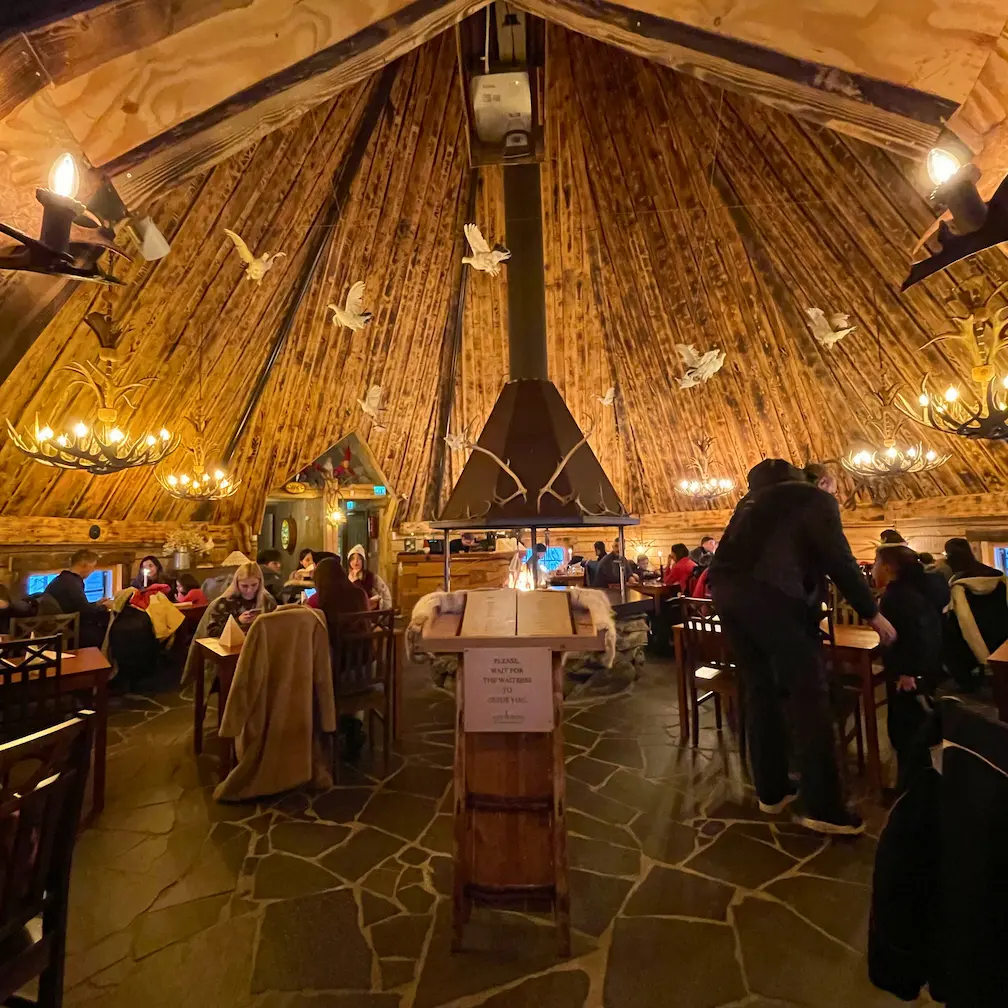
Roka street food and bistro
This is another recommendation in the city center of Rovaniemi. It is more modern and cheaper than Nili, with street-food-like takes on many traditional dishes, as well as some more international options like risotto for instance. This is the place where I had the reindeer burger with lingonberry mayonnaise. You don’t really need a reservation to go there for lunch, but if decide to try it in the evening it’d be smart to reserve a table in advance, as the place is very compact.
Campfire barista in Levi
This guy is incredible! You can find him close at the Levi Center, where he’ll prepare your favourite caffeinated drink (or tea) over an open fire. He has a wide range of options from espresso or kahvi to chaga chai latte. This is your go-to guy for anything chaga. If you’re not in Levi, you could get in touch with him on Instagram and enquire whether he’ll be in your area (he travels to different fireplaces around Levi and Rovaniemi, so you might get lucky!)
Café Uksakka in Luosto
This last recommendation is a little bit in the middle of nowhere (the village has basically one hotel, one restaurant and one shop) and even though there’s the possibility to go skiing there, I find it to be a bit of a hidden gem. Above the village there is a working amethyst mine that you can visit and get an insight of how this stone is being extracted.
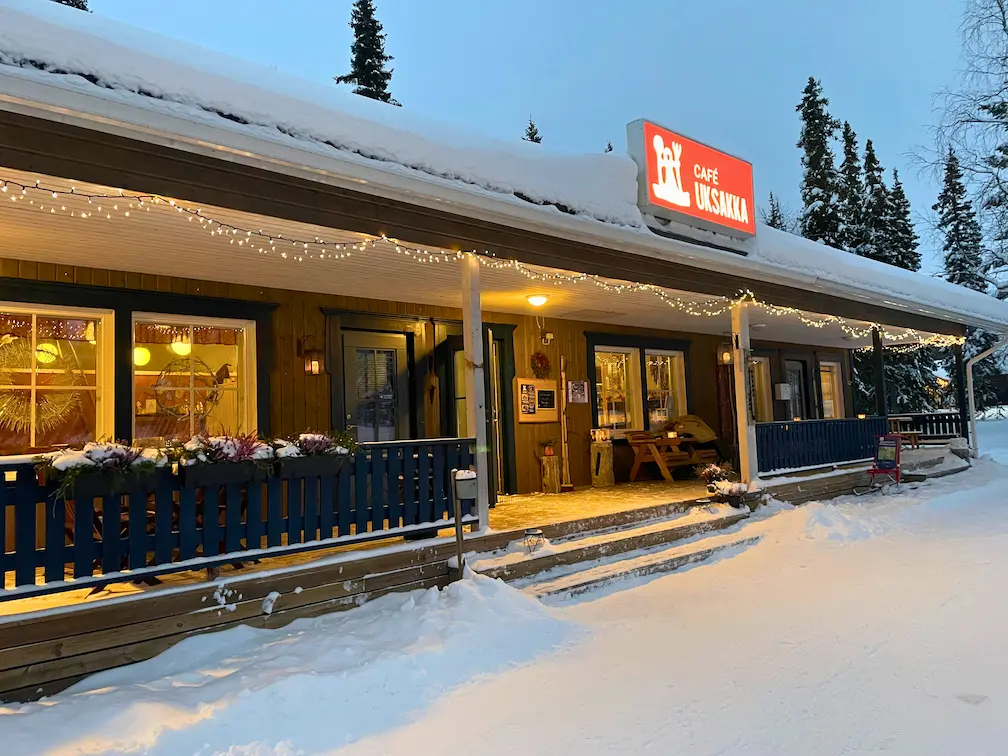
The café itself is nothing fancy, but the food is absolutely amazing. It’s all homemade and they basically only have reindeer in different forms (there is also a veggie option). The meat is sourced from local farmers, not difficult to do considering that Luosto is a big reindeer-herding area. If you want something outside the box, away from the masses in Rovaniemi, where you can enjoy authentic and local flavour – this is the place for you!
A final word and a place to avoid if you’re looking for a nice meal
A final thing I want to mention, so you can avoid a big disappointment and potentially save loads of money, is the ice restaurant in the Arctic Snow Hotel. A visit to the snow hotel is something worth doing. Finding out more about this incredible structure and how it comes to be – different every year, is an enriching experience. However, I would very strongly advise you against booking dinner in the Ice restaurant. It’s way too expensive, and yes, you’re paying for the experience itself, not the food, but at 69 EUR per person you’d expect at least a decent quality – and that’s not what you get. This was by far the worst place where we ate while in Lapland. To sum up – visit the Arctic Snow Hotel, avoid its restaurant.
I hope I was able to provide you with some useful tips for your preparation of your trip to Lapland. We were very positively surprised by the variety of flavours you can find in Lapland and utterly enjoyed immersing ourselves in the Lappish food culture.
Recent Posts
The Ultimate 5-Day Lapland Itinerary: Your Complete Arctic Adventure Guide
Ultimate 5-day Lapland itinerary: husky rides, frozen waterfalls, Northern Lights & Finnish sauna. Complete guide with accommodation tips.
Do You Need a Car in Lapland? Complete Rental Guide for Winter Travel
Wondering if you need a rental car in Lapland? Short answer: yes, if you want freedom beyond organized tours. Discover what it costs, how to choose the right vehicle, and essential winter driving...